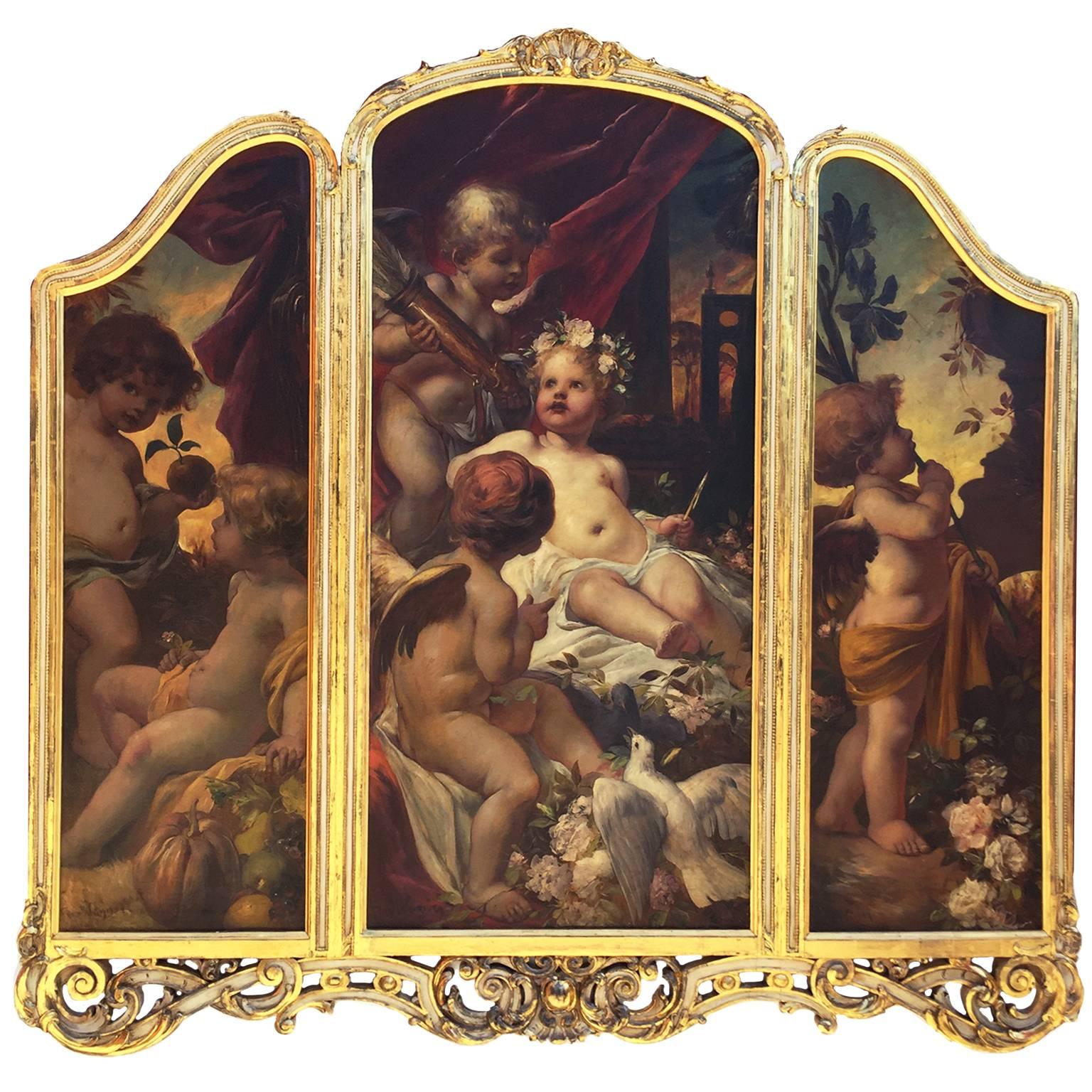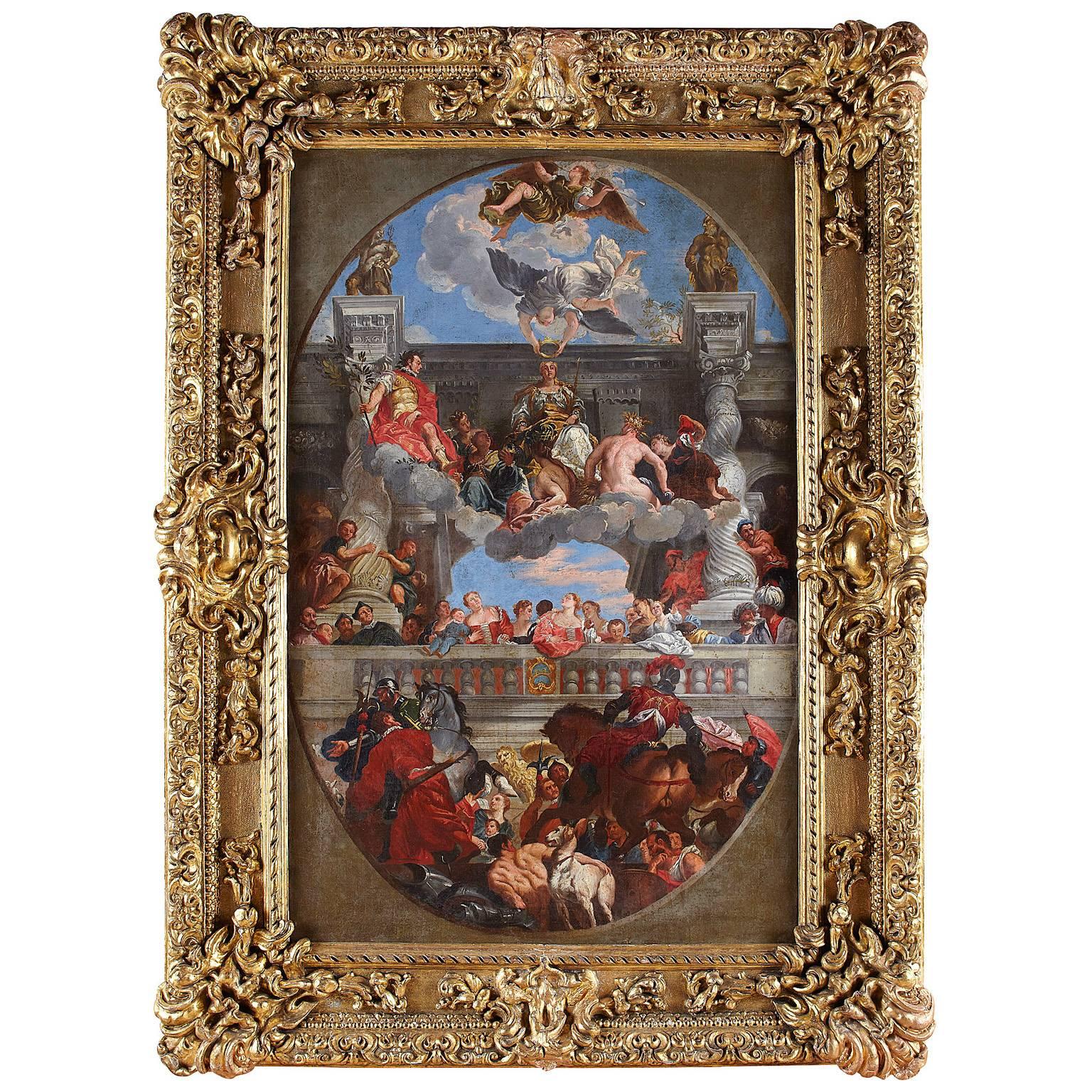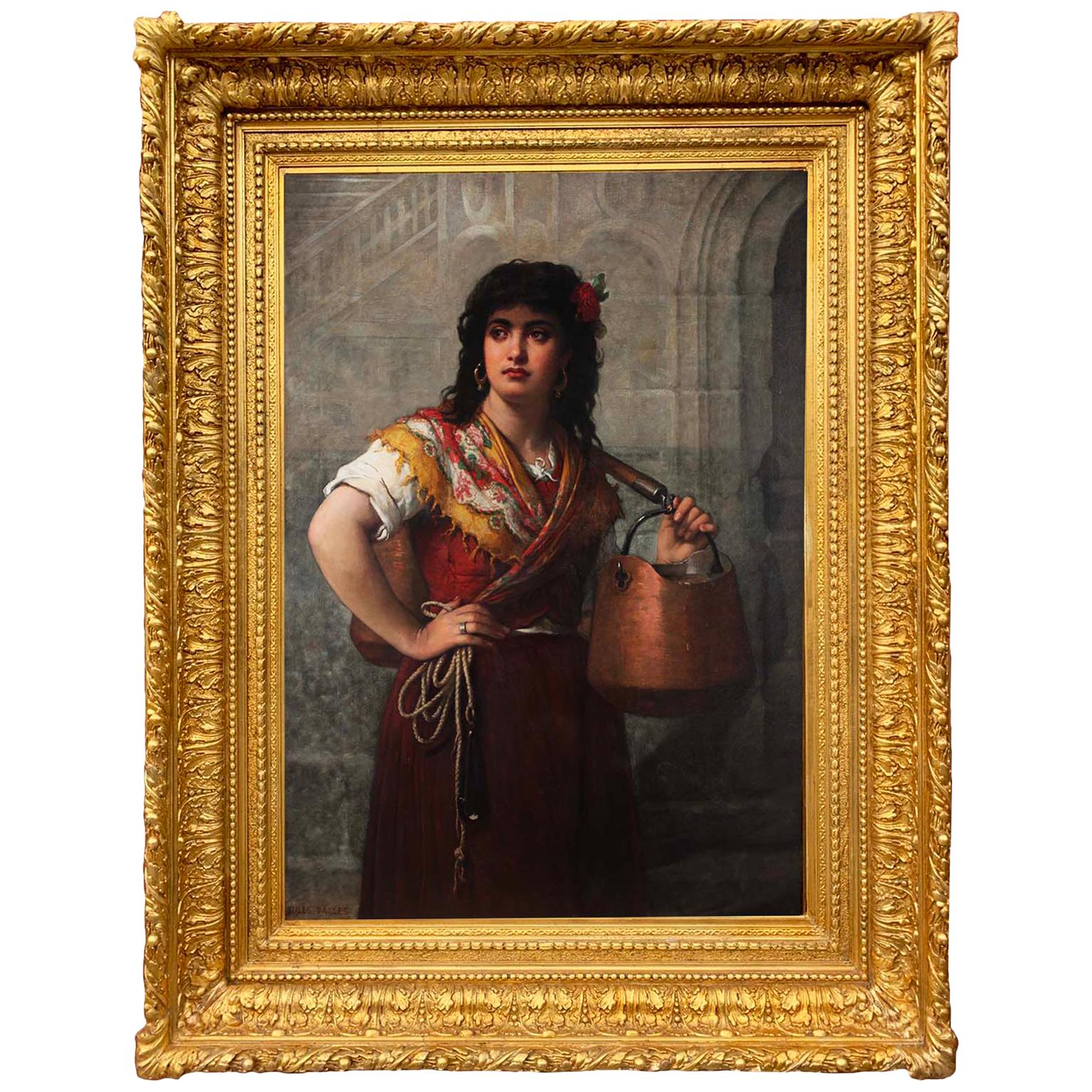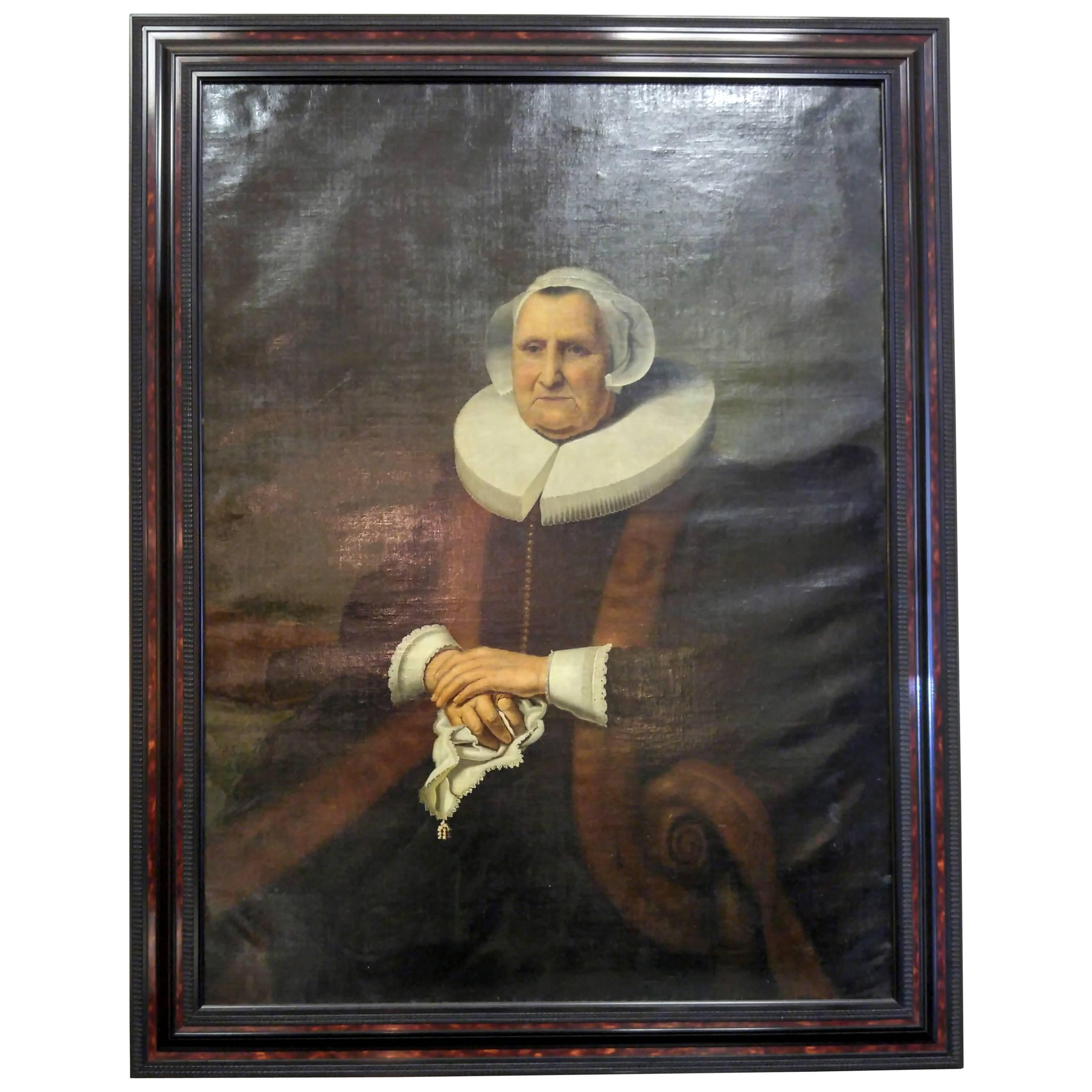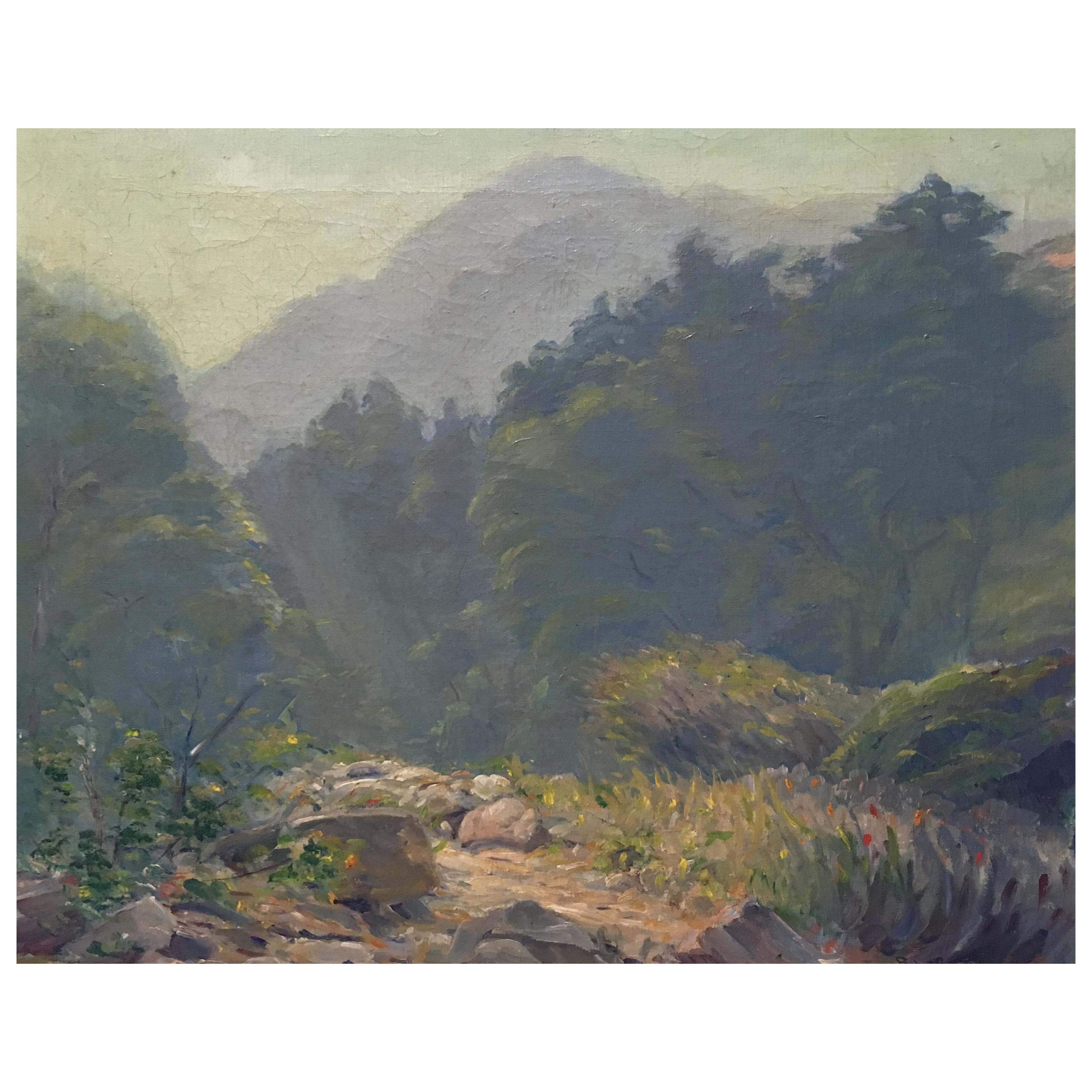Items Similar to Fine 19th Century Oil on Canvas "Triumph of Flora" Attr. Ferdinand Wagner II
Want more images or videos?
Request additional images or videos from the seller
1 of 10
Fine 19th Century Oil on Canvas "Triumph of Flora" Attr. Ferdinand Wagner II
About the Item
A very fine and large 19th century Louis XV style Whimsical Neoclassical Revival style Oil on Canvas "The Triumph of Flora" attributed to Ferdinand Wagner II (German, 1847-1927), school of François Boucher (French, 1703-1770). The impressive artwork depicting a semi-nude Flora hovering through the clouds surrounded by playful cupids, cherubs, love doves and a seated maiden, within white and grey clouds, offering her Spring flower bouquets and floral wreaths, within a banded giltwood frame. Note: Previously used as a ceiling painting. Unsigned, Circa 1870.
Measures: Canvas height: 91 3/4 inches (233 cm)
Canvas width: 59 inches (150 cm)
Frame height: 61 3/8 inches (155.9 cm)
Frame width: 93 1/2 inches (237.5 cm)
Depth: 2 3/8 inches (6 cm)
Ferdinand Wagner II (German, 1847-1927) was the son of Passau Ferdinand Wagner Senior, a teacher at a vocational art school who began training him professionally at a young age. After traveling to Italy in 1867-1868, he continued with his art studies at The Munich Academy of Arts led by Peter Von Cornelius and Julius Schnorr Von Carolsfeld. Wagner II was influenced by the Munich school of master painters and by his art teacher, Karl von Piloty, who had been teaching at the Munich Art Academy since 1856. Piloty’s approach to historical paintings was influenced by the French art academic Paul Delaroche and by the fine artworks by Rubens and the Venetians.
After his return to Germany he was commissioned to decorate the former the Tenormayer Wine Tavern in Munich, subsequently he received numerous other commissions as a decorator. Ferdinand Wagner II wall paintings and ceiling frescos attracted the attention from the Munich City Hall and he was commissioned to decorate the cellar and at the German Theatre. He also decorated the dining room at The Drachenburg in the Königswinter on the Rhine, the Café of Roth and Luitpold in Munich and The Tivoli Restaurant in London. Between 1890 and 1891 he was comissioned numerous art works for the "Prince Bismarck" Steamboat. In Passau he created works at the town's City Hall. Between 1892 and 1916 he worked continuously decorating the Castle Ratibor by Roth where in 1894 he painted it's main artwork "The Triumph of Aphrodite". Amongst other works, in 1891 he decorated the facade at The Schwyz City Hall, in 1895 the Grand Hall ceiling fresco at the Castle Bueckeburg's, in 1897 the decoration of the large dining hall at the Famous Munich Hofbräuhaus and in 1899 he was commissioned to decorate the tower hall of the newly built Hamburg City Hall. In Passau, Ferdinand Wagner II was awarded numerous honors where, in 1887, he was named an Honorary Citizen, the Ferdinand-Wagner-Straße Street was named after him and the "Ferdinand Wagner Hall" at the Town's City Hall was named after him as well.
François Boucher (French 1703-1770) was a French painter in the Rococo style. Boucher is known for his idyllic and voluptuous paintings on classical themes, decorative allegories, and pastoral scenes. He was perhaps the most celebrated painter and decorative artist of the 18th century. He also painted several portraits of his patroness, Madame de Pompadour.
A native of Paris, Boucher was the son of a minor painter Nicolas Boucher, who gave him his first artistic training. At the age of seventeen, a painting by Boucher was admired by the painter François Lemoyne. Lemoyne later appointed Boucher as his apprentice, but after only three months, he went to work for the engraver Jean-François Cars. In 1720, he won the elite Grand Prix de Rome for painting, but did not take up the consequential opportunity to study in Italy until five years later, due to financial problems at the Académie royale de peinture et de sculpture. On his return from studying in Italy he was admitted to the refounded Académie de peinture et de sculpture on 24 November 1731. His morceau du reception (reception piece) was his Rinaldo and Armida of 1734.
Boucher became a faculty member in 1734 and his career accelerated from this point as he was promoted Professor then Rector of the Academy, becoming head of the Royal Gobelins Manufactory in 1755 and finally Premier Peintre du Roi (First Painter of the King) in 1765.
Boucher died on 30 May 1770 in his native Paris. His name, along with that of his patron Madame de Pompadour, had become synonymous with the French Rococo style, leading the Goncourt brothers to write: "Boucher is one of those men who represent the taste of a century, who express, personify and embody it."
Boucher is famous for saying that nature is "trop verte et mal éclairée" (too green and badly lit). Boucher was associated with the gemstone engraver Jacques Guay, whom he taught to draw. Later Boucher made a series of drawings of works by Guay which Madame de Pompadour then engraved and distributed as a handsomely bound volume to favored courtiers. The neoclassical painter Jacques-Louis David began his painting instruction under Boucher.
Reflecting inspiration gained from such artists as Peter Paul Rubens and Antoine Watteau, Boucher's early works celebrate the idyllic and tranquil portrayal of nature and landscape with great elan. However, his art typically forgoes traditional rural innocence to portray scenes with a definitive style of eroticism as his mythological scenes are passionate and intimately amorous rather than traditionally epic. Marquise de Pompadour (mistress of King Louis XV), whose name became synonymous with Rococo art, was a great admirer of his work.
Boucher's paintings such as The Breakfast (1739), a familial scene, show how he was as a master of the genre scene, where he regularly used his own wife and children as models. These intimate family scenes are contrasting to the licentious style seen in his Odalisque portraits.
The dark-haired version of the Odalisque portraits prompted claims by the art critic Denis Diderot that Boucher was "prostituting his own wife", and the Blonde Odalisque was a portrait that illustrated the extramarital relationships of the King. Boucher gained lasting notoriety through such private commissions for wealthy collectors and, after Diderot expressed his disapproval, his reputation came under increasing critical attack during the last years of his career.
Museums with paintings by François Boucher (French 1703-1770):
The Metropolitan Museum of Art, New York, NY
The J. Paul Getty Museum, Los Angeles, California
The British Museum, London UK
Musée du Louvre, Paris France.
- Attributed to:Ferdinand Wagner II 1 (Artist)
- Dimensions:Height: 93.5 in (237.49 cm)Width: 61.38 in (155.91 cm)Depth: 2.38 in (6.05 cm)
- Style:Neoclassical Revival (In the Style Of)
- Materials and Techniques:
- Place of Origin:
- Period:
- Date of Manufacture:circa 1870
- Condition:Repaired: In paint touch ups. Wear consistent with age and use. Minor losses. Minor fading. Very impressive artwork in its original canvas, craquelure runs throughout, stretcher marks slightly through, surface with age dirt, edges partially abraded with a couple of small screw holes at the edges. Under UV-light varnish appears. View images.
- Seller Location:Los Angeles, CA
- Reference Number:
About the Seller
5.0
Vetted Seller
These experienced sellers undergo a comprehensive evaluation by our team of in-house experts.
Established in 1982
1stDibs seller since 2016
114 sales on 1stDibs
Typical response time: <1 hour
- ShippingRetrieving quote...Ships From: Los Angeles, CA
- Return PolicyThis item cannot be returned.
More From This SellerView All
- German 19th Century Oil on Canvas Triptych of Cherubs by Ferdinand Wagner IIBy Ferdinand Wagner II 1Located in Los Angeles, CAFerdinand Wagner II (German, 1847-1927) A very fine and charming triptych group of three oil on canvas laid on board titled "An Allegory to Spring" each panel depicting different playful and joyous scenes of putti and a cherubs reminiscent of spring, love and peace. The center panel depicting a seated putto, crowned with flowers, a standing putto behind him holding a sack of arrows and a seated cherub facing him next to a watchful peace dove on top resting of a flower bouquet. The left panel depicting a seated putto next to a standing putto with a freshly harvested apple. The right side panel depicting a standing cherub holding a fig branches with leaves. All three-in-one panels within individually carved giltwood frames. All panels signed at the lower left: Ferd. Wagner, circa 1890. Ferdinand Wagner II (German, 1847-1927) was the son of Passau Ferdinand Wagner Senior, a teacher at a vocational art school who began training him professionally at a young age. After traveling to Italy in 1867-1868, he continued with his art studies at The Munich Academy of Arts led by Peter Von Cornelius and Julius Schnorr...Category
Antique Late 19th Century German Rococo Revival Paintings
MaterialsCanvas, Wood
- 18th-19th Century Oil on Canvas "The Triumph of Venice" After Paolo VeroneseBy Paolo VeroneseLocated in Los Angeles, CAA very fine and Large Italian 18th-19th century oval-shaped oil on canvas titled "The Triumph of Venice" After the original work by Paolo Veronese (Venice, 1528-1588). The original of this painting hangs in the Palazzo Ducale, Venice. The 'Ricci' coloration suggests a late 17th-early 18th century date. In 1715 Charles de la Fosse advised Ricci to paint only "Veroneses and no more Riccis", Venice, circa 1800. Measures: Height: 45 1/4 inches (115 cm). Width: 29 inches (73.7 cm). Frame height: 58 1/4 inches (147.9 cm). Frame width: 43 1/4 inches (109.9 cm). Frame depth: 5 1/4 (13.3 cm). Provenance: Royal Academy of Scotland. Paolo Veronese (Born 1528, Verona, Republic of Venice - died April 9, 1588, Venice) was an Italian painter of the Renaissance in Venice, famous for paintings such as The Wedding at...Category
Antique Early 1800s Italian Renaissance Paintings
MaterialsWood, Gesso, Canvas
- Jules Salles-Wagner, French, 19th Century Oil on Canvas: Water CarrierBy Jules Salles-WagnerLocated in Los Angeles, CAJules Salles-Wagner (French, 1814-1898) A Large and Impressive French, 19th century oil on canvas "The Water Carrier" depicting a standing and posing young peasant girl holding twin-...Category
Antique 19th Century French Country Paintings
MaterialsGesso, Canvas, Giltwood
- Federico Mazzotta 19th Century Oil on Canvas "Grandfather"By Federico MazzottaLocated in Los Angeles, CAFederico Mazzotta (Italian, 1839-1897) A Very Fine Italian 19th Century Oil on Canvas "Greeting Grandfather", depicting a joyous grandfather enjoying...Category
Antique 19th Century Italian Country Paintings
MaterialsCanvas, Giltwood
- 18th Century Oil on Canvas Mother & Child Attr Michael DahlBy Michael DahlLocated in Los Angeles, CAA very fine and large 18th century oil on canvas titled "Mother and Child" (Probably members of The Swedish Royal Family). Attributed to Michael Dahl (Swe...Category
Antique 18th Century Swedish Baroque Paintings
MaterialsGesso, Canvas, Wood
- French 19th Century Old Master School Oil on Canvas Titled "Leda and The Swan"Located in Los Angeles, CAA fine and large French 19th century old master school oil on canvas titled "Leda and The Swan" within a giltwood frame. Leda and the swan is a motif from Greek mythology, in which Z...Category
Antique 19th Century French Renaissance Revival Paintings
MaterialsGiltwood, Canvas
You May Also Like
- Lovers by a Fountain 19th Century Painting Oil on Canvas, Modesto Faustini, 1860Located in Rome, ITLovers by a fountain, painting oil on canvas, Signed left sight. Measures: cm 70 x 100 frame 118 x 145 Faustini Modesto. Brescia, 27 Maggio 1839 - Roma, 23 marzo 1891. Born i...Category
Antique 19th Century Italian Neoclassical Revival Paintings
MaterialsCanvas
- 19th century Dutch Portrait Oil on CanvasBy Ferdinand Bol 1Located in Savannah, GAEarly copy of Dutch painting. Oil on canvas in antique style wooden frame. “Elisabeth Bas (1571, in Kampen – 2 August 1649 in Amsterdam) was a figure in the Dutch Republic. She was the wife of Jochem Hendrickszoon Swartenhont, an admiral in the navy of the Dutch Republic and military hero. The portrait is now in the Rijksmuseum Amsterdam, where it is known as Elisabeth Bas and attributed to Ferdinand Bol...Category
Antique Early 19th Century Dutch Baroque Paintings
MaterialsWood, Canvas
- California Oil on Canvas Painting, 19th CenturyLocated in Cypress, CACalifornia oil on canvas landscape painting, "Evening Glow" - Otto Robert Gaensslen (1876-1915; American) Late 19th-early 20th century. Artist Bio: ...Category
Antique Late 19th Century American Paintings
MaterialsCanvas
- 19th Century French Oil Painting on Canvas of FloralLocated in Houston, TX19th Century French oil painting on canvas of floral. Oil painting on canvas framed with a liner and gilt wooden frame.Category
Antique 19th Century French Modern Paintings
MaterialsCanvas, Wood, Paint, Giltwood
- 19th Century Egyptian Figures Continental Oil on CanvasLocated in North Miami, FLA pair of early 19th Century Continental School Oil on canvas. One portrays Egyptian Figures at a table with Hieroglyphics, and the other one a flute player and a singer. The scenes are from a funerary banquet, from the Tomb of Nenkhef. Both are framed in matching silver gild...Category
Antique 18th Century Egyptian Decorative Art
MaterialsCanvas, Paint
- 19th Century French Framed Impressionist Oil on CanvasLocated in Houston, TX19th century French framed impressionist oil on canvas. Stunning 19th century French framed impressionist oil on canvas. This beautiful French oi...Category
Antique 1870s French Romantic Paintings
MaterialsCanvas, Wood
Recently Viewed
View AllMore Ways To Browse
German 19th Century Oil Canvas
Cloud Painting 19th Century
Model Of Castle
Antique Elite Furniture
Antique Restaurant Furniture
Antique Painted Furniture Uk
Large German 19th Century Painting
19th Century Floral Oil Painting
German Classical School
Oil Xv
Lit Wall Art
Gemstone Painting
Blonde Antique Furniture
Antique Blonde Furniture
Louis Xv Pompadour
Antique Revival New York
Louis Tivoli
Circa 1870 Loved
